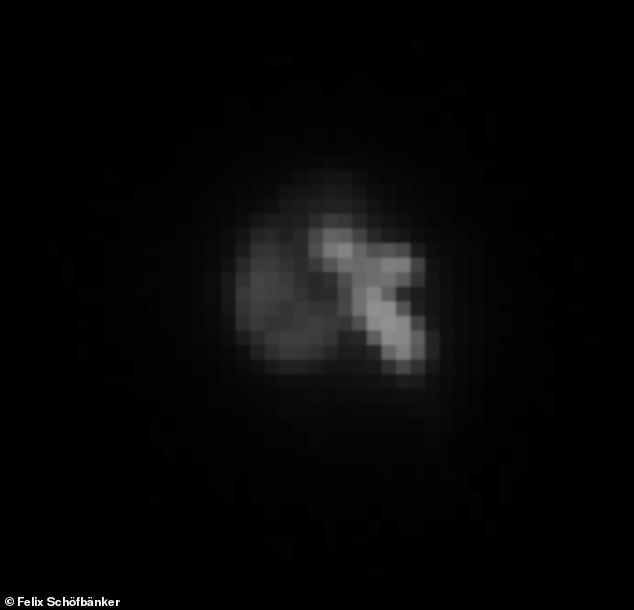
An amateur astronomer believes he has taken the first photo of a top-secret American spacecraft.
Felix Schöfbänker of Austria claims he has taken photographs of a secret fleet of spy satellites operated by a shadowy DoD agency that hunts down international terrorists, drug dealers and criminals for the US government.
The (Future Imagery Architecture) FIA radars, also known as Topaz, are five Boeing aircraft powerful enough to provide high-definition images of targets on the ground 24 hours a day.
Using a telescope built to track and photograph satellites, Schöfbänker observed “things previously unknown or only speculated about” — including their size, shape and position in the sky.
The space watcher shared what could be the only images from America’s secret spy satellites. The photo shows a satellite from Future Imagery Architecture (FIA-Radars), nicknamed Topaz
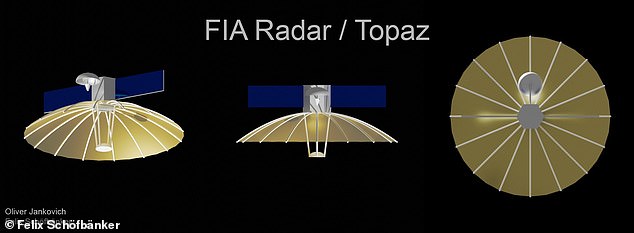
The (Future Imagery Architecture) FIA radars, also known as Topaz, are five Boeing aircraft powerful enough to provide high-definition images of targets on the ground 24 hours a day (a model is shown here)
The US launched its first spy satellite, CORONA, in 1960 to photograph enemies in China and the Soviet Union. The focus was on the speed at which China and the Soviet Union were producing long-range bombers and ballistic missiles and where they were being deployed.
The satellite images captured all Soviet launch sites for medium-range, intermediate-range and intercontinental ballistic missiles.
“Without CORONA, the US might have been unfairly pressured into launching World War III,” the Central Intelligence Agency (CIA) said in a statement.
The US leads the world with more than 200 space telescopes, and Schöfbänker has observed several in recent months.
The stargazer recently shared his discoveries with Space.comin which he described in detail the mechanics and technologies he had observed.
Using his Dobsonian telescope, he discovered several FIA radars equipped with Synthetic Aperture Radar (SAR), which allows the US to send radar signals through clouds, foliage and shallow ground.
The images are created by sending microwave pulses to the Earth’s surface and measuring the reflected signals.
Topaz is a series of five satellites developed by Boeing. The first was launched in 2010 and the last in 2018.
The U.S. government has been secretive about its capabilities, releasing only details about the Topaz 1, which features a nuclear power system, an attitude control system and a cylindrical monocoque aluminum structure.
It is unclear which model Schöfbänker observed, but he could make out other details.
‘From my images I gather that these satellites have a parabolic mesh antenna that is about 12 meters long [39 feet] in diameter, and two solar panels with approximately 10 meters [33 feet] “From the wingspan,” he told Space.com.
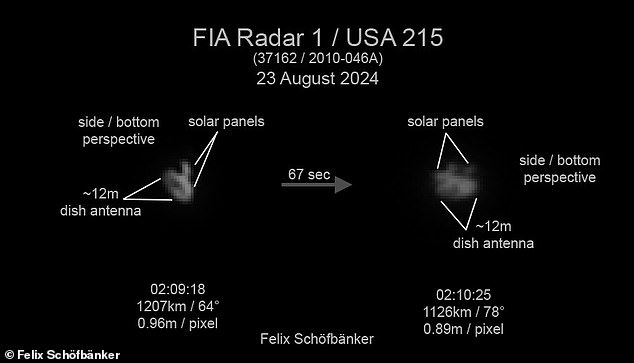
Topaz, developed by Boeing, comprises a series of five satellites used to gather intelligence on the ground. Felix Schöfbänker, from Austria, spotted all five in orbit
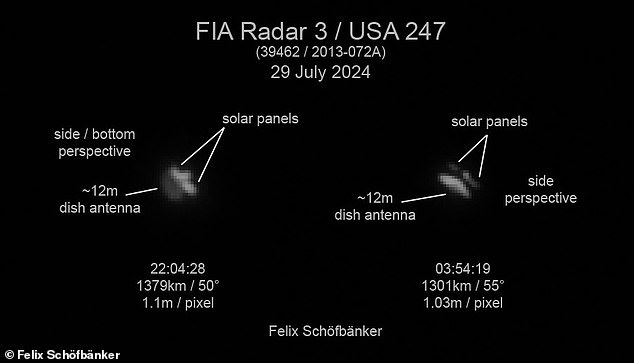
The satellites pick this up by sending microwave pulses to the Earth’s surface and measuring the reflected signals
‘There is also another bright object between the solar panels, which I interpret as an up- and downlink antenna, but it could be something else.’
Schöfbänker further explained that the satellite’s antenna moved six times to the left and 22 times to the right during his observations.
He also had a number of KH-11 satellites in his sights, which convert light into electronic signals.
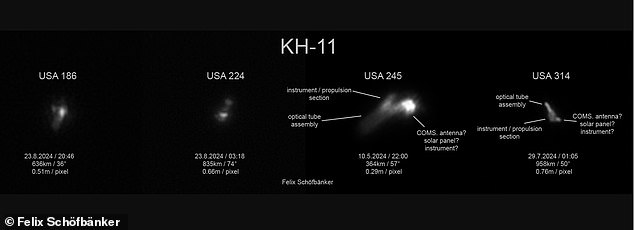
Another satellite, the KH-11, was also captured. This was the first satellite to provide real-time information to officials.
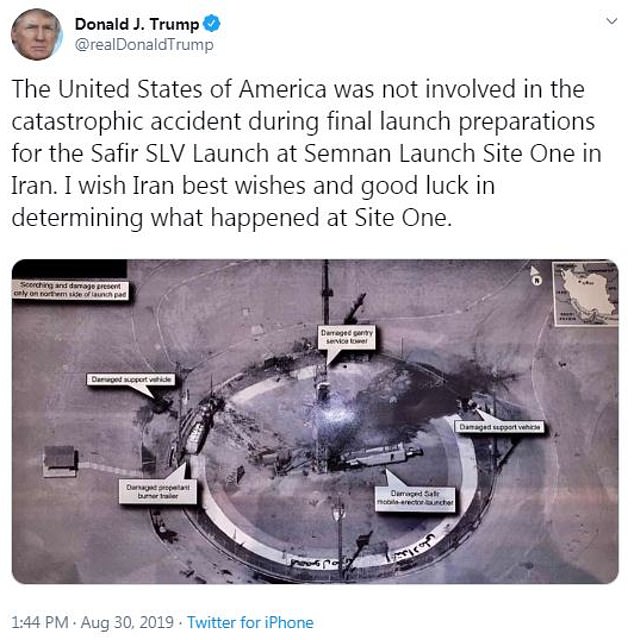
Donald Trump shared a declassified photo of an Iranian missile launch site captured by a KH-11 launched in 2011 while he was president in 2019
The KH-11, developed by Lockheed Martin, is believed to use a two-meter-long primary mirror, allowing the satellite to identify objects as small as three centimeters in size.
The first KH-11 was launched in December 1976. It was the first time that real-time information could be collected. Previously, it took days or even weeks to take pictures.
The need for real-time observations was often emphasized by officials during major events such as the Cuban Missile Crisis, the Six Day War, or the invasion of Czechoslovakia.
In 2019, then-President Donald Trump shared a declassified photo of an Iranian missile launch site captured by a KH-11 launched in 2011.
There are four of these satellites in orbit around the Earth.
“The oldest one that’s out there now was launched in 2005. It’s a third generation KH-11 called USA 186. The next two are called USA 224 and USA 245, and this is the fourth generation from 2011 and 2013,” Schöfbänker said.
“The newest is a fifth-generation spacecraft from 2021 and is called USA 314.”
His observations showed that they were about 11 meters long, with the mirrors varying in size depending on the generation.
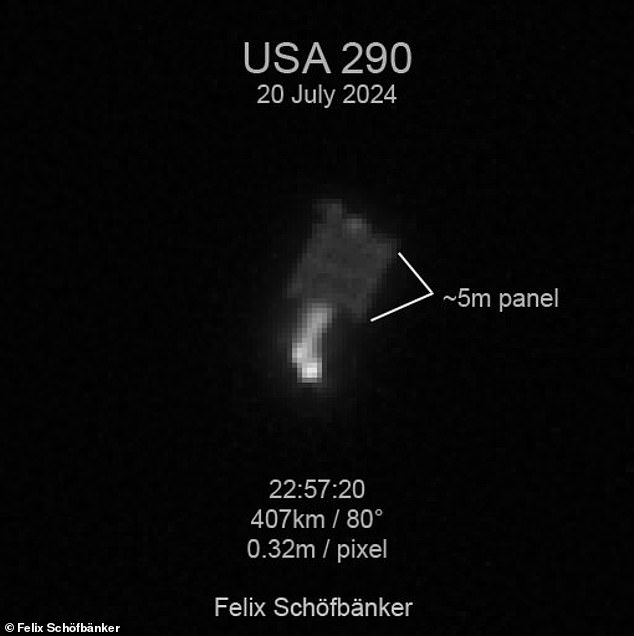
Another satellite, however, is of an unknown type. Schöfbänker suggested it was a USA 290, which officials have kept secret
The space observer determined that three generations of KH-11 were orbiting the Moon, with the mirror of the fourth measuring almost three meters in diameter.
On July 20, Schöfbänker posted a timelapse of a satellite on his website. This is perhaps one of the most secret satellites in the American arsenal.
Schöfbänker suggested it was a USA 290 or another KH-11, but noted that the images did not match those of the latter and that the two had been launched on different orbits.
Based on the observations, he determined that the spacecraft had a panel 5 meters long and an overall circumference of about 9.5 meters.
The USA 290 also collects real-time intelligence, but that’s all that’s known about America’s secret spy satellite.
